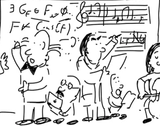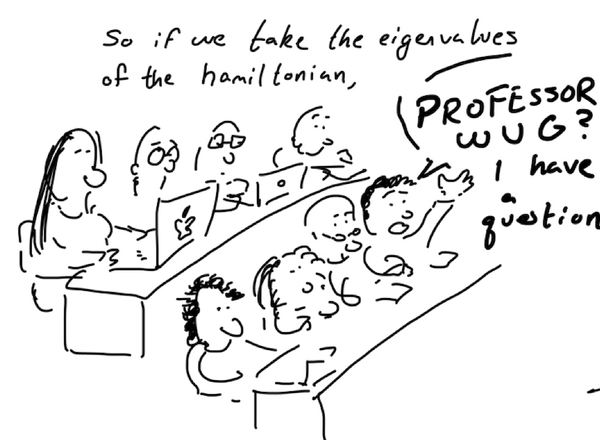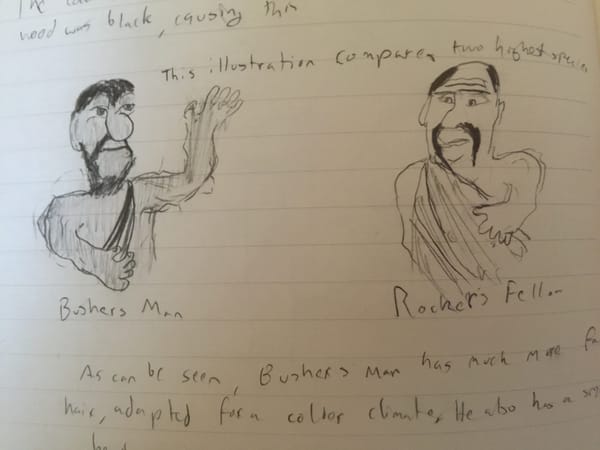The Medium, the Message, and the Myth of the Impervious Craftsman
Those in Whorf’s camp claimed that just about every aspect of human experience was constructed by language – a position they would abridge as “linguistic relativity.” Those opposing them adopted some version of the “impervious craftsman” mindset, arguing that language is but a tool...

There's something deceptive about the word "tool." The term encompasses everything from a pickaxe to a graphing calculator to your favorite social media app, and yet when we reason about "tools" we often imagine that they are all no different from hammers or monkey wenches. In particular, we imagine these tools as if wielded by the firm grip and steady eye of an expert craftsman guiding his saw. No matter the technology, we are quick to equate it with the saw (namely, assuming it is dumb and passive) and to compare ourselves with the expert craftsman (namely, firm willed and possessed of a clear aim). Crucially, we readily imagine the existence of boundaries between the tool and ourselves: we direct it. It responds to our direction, and there is only one direction of influence—from us to the tool. How could it be any different?
Call this the "myth of the impervious craftsman." In reality, few technologies affect us as simply as a monkey wrench. From fire to agriculture, from the printing press to penicillin, from Ford to Facebook, human tools have a rich history of reshaping human society in ways never imagined by their inventors. Unlike a hammer, these transformative technologies — like Gutenberg's bible or Facebook — trigger feedback loops between their users and designers. The craftsman becomes intoxicated by his carpentry, and the results are far-reaching and unpredictable. As Neil Postman has written, “Technological change is neither additive nor subtractive. It is ecological.”
Riddle Press has mused before on the consequences of these techno-ecological changes. In fact, lamenting them has become something of a trope. Cue the anxious newscaster:
In 2008, Twitter took the world by storm with a means of communicating in 180-character bursts. Little did they imagine that the American body politic would soon grow hopelessly addicted to their platform, leading political discourse to devolve into a brainless mire of insults and conspiracies…
This is the dark side of technological change.
But we've also written about the vast potential present on the light side – of purposeful humane technology and its potential to create transformative tools for thought that can harness the explosion of information and computational power from being a driving force of societal fracture into catalyzing a new intellectual renaissance!
“Hold on,” you might say. “I agree that the tools people use to communicate and consume information might have some small effect on public discourse. But c’mon – they’re just tools! Doesn’t most of the responsibility still lie with us, the users?“
There’s a spectrum of responses, which correspond to how much one believes in our myth of the impervious craftsman. It’s all in the answer to this question: how much separation is there between a user and her tool?
Indeed, if one believes fully in the imperviousness of the craftsman, the possible effect of any new technology seems small. From this viewpoint, it doesn’t matter whether you spend your free time reading Middlemarch or doomscrolling Twitter. From the carpenter’s viewpoint, it’s all wood (er, information), and you’re just choosing between a hand plane and a carving knife. It’s the same person wielding each tool, and the tool remains at arms length.
But alternatively, if you entirely reject the myth of the impervious craftsman, you’ll subscribe to some version of Marshall McLuhan’s aphorism, “the medium is the message.” Welcome to the realm of technological determinism, where what someone thinks is entirely determined by the tools she uses. If Cindy is caustic and cynical, it isn’t her true character, but the fact that she lives and breathes in a world where witty cynicism is rewarded with retweets. Meanwhile, if Pam the Pianist is peaceful and serene, it’s because she spends so much of her time engaging with a technology that rewards careful dedication. In this telling, from Twitter’s introduction, it was inevitable that the discourse of any society that used it would degrade to venomous sentence-length babble, this being the “resonant frequency” of the platform. There’s no separation between user and tool: the user is their tools.
“So which is it?” you ask, leaning forward slightly. “Wait, let me guess: this one of those questions without an answer.”
Not quite. We can make some reasonable hypotheses. Certainly, either extreme is senseless: neither is the user completely insulated nor completely determined by their tools. But where in the middle do we lie – towards which end, and facing which direction?
To ground this discussion, we need to return to the most consequential human technology.
No, not the iPhone. I was thinking of language.
Admittedly, language is a special case among human technologies, as it developed contemporaneously (and likely contributed to) significant evolution in the human brain. There's nothing in our genes that predisposes to, say, touch-type fluently, but there are specialized modules in the brain that equip us for the particulars of syntax and grammar found in language. This part of language – the cognitive machinery to use nouns and verbs – is firmly implanted in our genetic endowment, making this part of language as a human technology as much "human" as "technology."
But much of language isn't fixed by our genes, and varies widely between cultures. From the precise types of nouns a language uses, to the other patterns it employs (like recursion or the gendering of nouns) the diversity of human language gives one means of testing the extent to which tools can change elements of human thought and perception.
The answers are interesting not only to linguists, who want to know how much of the human experience their domain covers, but to anyone curious about the power of human technology. Indeed, we might take them as a first approximation of our answer. How impervious is the craftsman? To what extent is the medium the message? Among linguists, and with the special case of language, this debate has been raging for over a century.
It all begins with an insurance agent named Benjamin Lee Whorf.
Whorf’s obsession with the ways language shapes the human experience began, oddly enough, at the Hartford Fire Insurance company. Whorf was an investigator, tasked with unearthing the causes of fire-related accidents (and, presumably, trying to argue that they were not covered by the Hartford Fire Insurance Company). He began to notice a repeated pattern in his investigations, which someone else might have dismissed as “user stupidity” – but, to Whorf’s inquiring mind, was evidently a very particular stupidity, induced by misleading metaphors in common language.
Here’s an example (from Whorf's “The Relation of Habitual Thought and Behavior to Language”):
Around a storage of what are called 'gasoline drums’ behavior will tend to a certain type, that is, great care will be exercised; while around a storage of what are called 'empty gasoline drums’ it will tend to be different—careless, with little repression of smoking or of tossing cigarette stubs about.
They’re “empty,” right? What could go wrong?
Yet the 'empty’ drums are perhaps the more dangerous, since they contain explosive vapor. Physically the situation is hazardous, but the linguistic analysis according to regular analogy must employ the word 'empty,' which inevitably suggests lack of hazard.
Were the workers trained physicists, they might have different metaphors for the behavior of gasoline and gasoline vapor. But the term “empty” suggested a different analysis – with catastrophic consequences.
“Still,” you might say, “being cautious around explosives just seems like common sense! I still put this in the ‘user stupidity’ folder.”
Perhaps. Here’s a slightly subtler case.
A drying room for hides was arranged with a blower at one end to make a current of air along the room and thence outdoors through a vent at the other end. Fire started at a hot bearing on the blower, which blew the flames directly into the hides and fanned them along the room, destroying the entire stock. This hazardous setup followed naturally from the term 'blower’ with its linguistic equivalence to 'that which blows,’ implying that its function necessarily is to 'blow.’ Also its function is verbalized as 'blowing air for drying,’ overlooking that it can blow other things, e.g., flames and sparks. In reality a blower simply makes a current of air and can exhaust as well as blow. It should have been installed at the vent end to draw the air over the hides, then through the hazard (its own casing and bearings) and thence outdoors.
Here language is rather obviously more at fault. Imagine the poor fellow tasked with installing the deadly ‘blower.’ We can almost hear him muttering: seems like this thing must blow the air over the hides, so it must go back here…
Whorf realized that a large proportion of what qualifies as thinking is much like the mutterings of this hapless mechanic. It might be silently spoken, or just thought, but if it involves words passed in conversation between “I” and “me,” then it is subject to some linguistic misalignment that afflicted Whorf’s subjects.
In fact, Whorf thought, why limit this to reasoning about physical objects and their properties? If language undergirds our common sense about physical objects, what other parts of "common sense" are constructed entirely by words and the way we use them? Consider the way we think about space, or time – are these byproducts of the language we happen to have learned?
As one of Whorf’s professional correspondents, the Yale linguist Edward Sapir wrote:
It is quite an illusion to imagine that one adjusts to reality essentially without the use of language and that language is merely an incidental means of solving specific problems of communication or reflection. The fact of the matter is that the 'real world’ is to a large extent unconsciously built up on the language habits of the group. We see and hear and otherwise experience very largely as we do because the language habits of our community predispose certain choices of interpretation.
With this, the Whorfian debate was born. It mirrors our scuffle about the imperviousness of the craftsman. Those in Whorf’s camp claimed that just about every aspect of human experience was constructed by language – a position they would abridge as “linguistic relativity.” Those opposing them adopted some version of the “impervious craftsman” mindset, arguing that language is but a tool, and we are but its users. Sure, the language we speak affects the sounds that issue from our mouths, but very little else. The two camps of this debate went to battle in, for linguists, the customary way: doing experiments and writing papers on the results.
Let’s see what they found.
What do we experience which isn’t mediated by language?
Well, what about experience itself? If the Whorfian camp could demonstrate a direct effect of language on raw perception, it would be linguistic relativity’s coup d'état.
Indeed, there was reason to think that language might have this kind of effect on perception. Languages differ widely in the ways they describe everything from the relation of objects in space to whether they prefer to describe the path or manner of motion of a moving object. They even vary dramatically in the number of words their speakers commonly use to describe colors. Could this mean that we English speakers are wandering around with an entirely different experience of reality than an Arabic or Navajo speaker?
I’ll spoil the outcome for you: the coup failed. Linguists excitedly delved into each of these possible linguistic effects, from the effects of language on how people reconstruct objects in space, to whether they find the way someone moves more important than where they are moving. In hindsight, these experiments can seem laughably vague (“Is the picture with Fat Albert running up the stairs more similar to the picture of him running down a deserted alleyway, or the picture of him walking up the same staircase?”). None of them found compelling, reproducible evidence of linguistic effects on raw perception. But where the coup failed is telling, as it illustrates just how close to the boundary of human perception language can approach.
Let’s dive into one representative experiment by Winawer et al, suggestively titled “Russian Blues Reveal Effects of Language on Color Discrimination.” As anyone who grew up singing “ROY G. BIV” as a mnemonic for the colors of the rainbow knows, the spectrum of “color space” defies tidy categorization into a handful of words. Colors are continuous; words are not – so it should be no surprise that different languages not only have different words for colors, but have words for different colors.
I can see you thinking there: “Does this mean that some speakers of some languages can see colors that others can’t?”
Winawer suspected that some version of this might be true, and found the perfect test case. While English speakers (hi!) have a single word for “blue,” Russian speakers possess no such overarching category. Their blues come in two terms – either “goluboy” or "siniy", resulting in what Winawer calls an “obligatory distinction” between light and dark blue.
Seizing upon this, Winawer subjected a hapless group of Russian and English speakers to pictures like this, paired with the question: “Which of the two bottom squares matches the top?”

In this case, it’s easy enough, but as the colors shown become closer, the task becomes harder – and, in Winawer’s results, much harder for English speakers than for Russian speakers. Armed with their “obligatory linguistic distinction” between dark and light blues, Russian speakers discriminated the true match with much higher accuracy.
“There it is! It’s linguistic relativity! Whorf was right!‘’
Not so fast. Winawer repeated this experiment with one change: the subjects were forced to undergo “interference,” by either speaking a series of numbers or remembering the positions of objects in a grid, tasks constructed to interfere with, respectively, linguistic processing and spatial reasoning. And the results changed: under verbal interference (but not spatial interference), the Russians lost their discriminatory edge.
Linguists drew one of two conclusions from this. On one hand, this might seem like grounds for dismissing the result. If the question was a difference in raw perception between English and Russian speakers, the fact that this difference disappeared is suspicious. This suggested that the effect wasn’t actually measuring differences in raw perception of colors, but the effect of some sort of continuous internal monologue about the colors. In other words, the Russian speakers didn’t see the colors and immediately sense the difference with a greater acuity than English speakers – in actuality, they were consulting some internal monologue about the colors they saw: “Let’s see… this one looks like golubuy, and, ah, that’s golubuy also, so it’s the left one.” When forced to recite numbers, this internal monologue vanished, leaving both camps on equal footing.
What does this mean? If the result disappears when the monologue vanishes, it must be a “language on language effect.” The Russians didn’t see the world differently, they just applied different words to it when asked by experimenters to interpret different types of blue. So much for linguistic relativity.
Or is it? Alternatively viewed, the fact that language snuck into a task as simple as color perception is rather remarkable. Even if the effect disappears when the internal monologue is silenced, the fact that an internal monologue had a significant effect on the accuracy of color discrimination is astonishing. A “language on language” effect it might be, but Winawer’s “Russian blues” reveals how pervasive such language is, and how readily it influences even activities as basic as perception.
The Whorfian coup on basic perception mostly failed, but perhaps this isn’t entirely surprising. Our raw perceptions of the world are, after all, genetically specified – preprogrammed, as it were. Babies can discriminate colors well before they learn to speak. It would be bizarre for the words they learn to disrupt this perception.
In many ways, the more surprising result would be if there are activities distinct from communicating which language makes possible, especially if this is achieved using parts of language which are not “preprogrammed,” but vary between cultures. This rescues the original meaning of Whorf’s linguistic relativity – interrogating the metaphors with which language seeds its speaker's interpretations of reality.
Many of these metaphors are so obvious they are easily overlooked (like the “empty” gasoline drums which were supposedly free of danger). But perhaps there are also subtler metaphors, based in syntax instead of vocabulary, which subtly guide thought or even make whole categories of thought possible.
“This is starting to get a little hazy,“ you say. “Can we have some concrete examples?”
Certainly. Let’s start with a story:
Sally left her toy in the sandbox. After Sally left, Anne stole Sally's toy and hid it the treehouse. When Sally returned, she wanted to find her toy. Where did Sally look for her toy?
To you and me, the answer seems obvious. Sally doesn’t know her toy has been moved; she’s laboring under a delusion (the technical term is false belief), so she’ll look for the toy where her “false belief” tells her it is.
Interestingly, though, young children invariably get this wrong. They seem to have difficulty with separating what Sally thinks about the world from what they know about the world, and will perkily reply: “Sally will look in the treehouse, where her toy is!” Indeed, this difficulty persists until around age five, when most children figure out what’s going on. Cognitive scientists speak of these children acquiring a “theory of mind,” as in a “theory about other people’s minds,” and argue about what precisely triggers this. Is it some growth spurt in the mind that suddenly enables five-year olds to reason about Sally’s beliefs? Or do they just develop the self-control to stop themselves from blurting out the right answer? This is an open question.
Notably, our ability to make sense of these situations is surprisingly fragile. You might be priding yourself on your mental competence, but take a stab at this:
Sally left her toy in the sandbox. Anne saw Sally leave and moved her toy into the treehouse. But Victor saw Anne moving Sally’s toy, and when Anne’s back was turned, relocated it to the swing set and told Sally he had moved it. Pablo saw Victor doing this, and told Anne about this, and so he and Anne moved the toy by the soccer goal. But after Pablo left, Leo grabbed Sally’s toy and put it back in the sandbox. Where does Pablo think that Victor thinks Anne thinks Sally thinks her toy is?“
Doubtless, you see what I mean. Chain enough clauses onto the question, and this simple Sally-Anne test turns into a brain-teaser, in which the answer is sufficiently non-obvious that you become aware of how your brain tries to solve the problem.
If it’s anything like mine, it involved a little mental monologue: “Well, Pablo saw Victor moving the toy to the swing set, so Pablo thinks that Victor thinks that Anne thinks the toy is still in the treehouse, and Pablo thinks that Victor thinks that Anne still thinks that Sally thinks her toy is in the sandbox…”
Indeed, research on this grand sounding topic of “theory of mind” has a grand sounding hypothesis: all false belief reasoning is dependent upon linguistic reasoning! They can cite several strong results to back up this hypothesis. For one, autistic children (who have difficulty with false belief tasks) improved their performance with false beliefs just by practicing a grammatical structure called the “sentential complement,” which is used in the chains of “he thinks that she thinks…”.
But even more compellingly, regular adults do much worse on these false-belief test under verbal interference than other interference of equivalent difficulty. This is true even in a visual false-belief task – watching actors move objects around and pointing to the suspected location. If our “theory of mind” reasoning were an innate cognitive skill, we’d expect that repeating words would have no more effect on performance than tapping rhythms. But the difference was significant. Like Russian speakers’ savviness at blue discrimination, our skill at decoding false-beliefs seems dependent on linguistic processing.
Let’s return to the myth of the impervious craftsman, from the lens of language. Each side of the debate on linguistic relativity interprets this craftsman differently. The adamant “linguistic absolutists” maintain that the mind of the craftsman is unperturbed by the tools he uses – the mind of the speaker is unaffected by the language she speaks, the language being but a tool, picked up to achieve a purpose, and modified if the purpose isn’t met. In this telling, whatever we call “intelligence” lies exclusively with the craftsman; it is a user, not a product of its tools.
In Whorf’s vivid telling, there is no separation between the tools and the craftsman. The language makes the speaker as much as the speaker makes the language. We have seen that parts of this are almost certainly false – color perception, for instance, in raw form is equivalent between speakers of different tongues. But even here, there is subtlety, as language spills into unexpected parts of our experience via our continuous mental monologue.
The Whorfian vision doesn’t need to be complete to be correct. The fundamental idea, motivated by that “empty gasoline drum,” was that a speaker’s intelligence can’t be wholly separated from their language. There is no little homunculus nestled behind our eyes, wielding words like a carpenter with a saw. The medium participates in the message. The language does some of the computation – it processes some of the intuition – and, as with the case of false beliefs, may be the driving engine behind whole categories of thinking.
There’s little reason to think this trick is unique to language.
The famed physicist Richard Feynman once became agitated over scraps of paper. He was in conversation with the historian Charles Weiner who made some comment about the Feynman’s scratch paper being a fascinating “record of his day-to-day work.”
“I actually did the work on the paper,” Feynman replied.
“Well,” Weiner said, “the work was done in your head, but the record of it is still here.”
“No,” Feynman said. “It’s not a record, not really. It’s working. You have to work on paper and this is the paper. Okay?”




